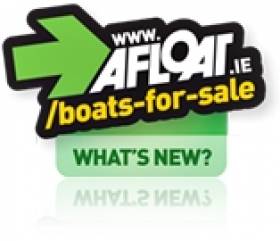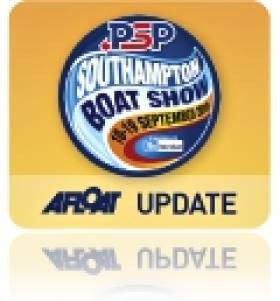Displaying items by tag: Hugh Mockler
Dufour 470 Launch Shows Off 'Enormous Cockpit' of New French Yacht Model
Recently launched in La Rochelle, the new Dufour 470 model will tour France and then Europe, as well as the United States, Australia and Asia in its worldwide launch.
"The 470 represents continuing advancements with the Dufour range of yachts", according to Irish agent Hugh Mockler of Crosshaven Boatyard who told Afloat "the cockpit is enormous and well thought out as is her interior".
 The Dufour 470 feels and looks like a 50 footer both inside and out
The Dufour 470 feels and looks like a 50 footer both inside and out
If not yet in the flesh, then Paris Virtual Nautic is the first opportunity at least to visit this new model thanks to an on-screen boat show environment using the Dufour virtual Marina interface launched last April, and now optimised with new features and layout choices.
Cork Harbour based Mockler also says of the new marque, "she feels and looks like a 50-footer both inside and out. Like her sisters, she is quick and easy to handle".
 Dufour 470 - cockpit is enormous and well thought out as is her interior
Dufour 470 - cockpit is enormous and well thought out as is her interior
Mockler also says her list of options are endless which means you have the opportunity to have her set up for easy cruising or for even more performance.
Delivery times are already moving rapidly into 2022, Mockler says.
Elan 340 for Sale (That Can Pay Her Running Costs!)
#BOATS FOR SALE – A 'highly spec'd and well maintained' 2007 Elan 340 has just come on the market. According to the broker Crosshaven Boatyard in Cork 'the yacht has the unique advantage of earning an income for her new owners'.
Priced at €73,500 ex VAT, this hi-tech designed performance cruiser has been used as a sail training and charter yacht with Kinsale's Sovereign Sailing. James Lyons from Sovereign Sailing told Afloat.ie "The Elan is a perfect fit for our fleet as she is licensed by the DOT for skippered and bareboat charter. The concept of our management fleet is the that owners use the boat as much as they wish and we use it for around 6-8 weeks a year which covers all her annual expenses".
She can be viewed through Hugh Mockler of Crosshaven Boat Yard. The full advert giving detailed specs is on the Afloat Boats for Sale site HERE.
Afloat's March/April Issue Out Next Week!
Is there no end to the achievements of Irish boaters against seemingly impossible odds?
The winter may have been a time of hibernation for some of us but as the stories in Afloat's March/April issue will bear out Irish sailors have been battling the elements all winter long.
James Carroll competed in January's Sydney-Hobart offshore race and, much closer to home, Paul A. Kay journeyed through snow and ice in December from Dun Laoghaire to a new marina on Valentia Island.
As if to prove a point that we're down but not out, a winter of results on foreign waters includes a win in the Mirror World Championships in Australia and a top Olympic result in Florida, USA.
They are gutsy performances from youth teams that shows, if nothing else, the next generation of Irish sailors is really up for a fight. All this plus lots, lots more on news-stands next week!
Selected contents from Ireland's only boating magazine include:
News
Surveyors Issue Boat Launch Warning, Buoyant Dinghies Buck the Market, Ice Diving in Ireland, German U-Boat Rediscovered in Cork Harbour, an Historic Trophy for South Pacific Dream Cruise, MGM open in Cork, Hugh Mockler joins Crosshaven Boatyard plus lots, lots more.
News Focus
A new masterplan for Dun Laoghaire harbour is badly needed but it needs buy in from all those that use it
Going Offshore
The tenth Dun Laoghaire to Dingle offshore race was launched in style
Marine Conference
Combating the downturn was the focus of a unique marine gathering on both sides of the Irish sea.

Gear Review
New dinghy gear, a new Crosshaven boot from Dubarry, a new raincoat for girls and an upgrade for Musto's MPX.

This Island Nation
The decision to shut down the fog signals was based on a detailed risk assessment. Tom MacSweeney on the loss of fog horns
Sailor of the Year
Anthony O'Leary of Cork is the Afloat.ie/Irish Independent "Sailor of the Year" in celebration of his outstanding achievements afloat nationally and internationally.
Tall Ships
W M Nixon looks at the realities of national sail training in the 21st Century.
Tall Ship Conference
Ireland could yet have a tall ship to replace the Asgard II and the Lord Rank, if a new group formed to press for a replacement is successful
Racing update
Ulstermen's World Title, Topper worlds for Dun Laoghaire, Two Irish campaigns line up for Figaro Race, SB3 Sailors Cry Foul at Dun Laoghaire Parking Fees and an Irish entry in the Moth worlds in Australia, Irish Mini 6.50 Campaign in Prospect.

Youth Worlds preview
Results achieved abroad this Winter are the backbone for further Irish youth
success

Figaro Preview
Two fledgling Irish La Solitaire du Figaro campaigns edged closer to the start line last month
Volvo Dun Laoghaire Regatta
Volvo Dun Laoghaire regatta has taken in 22 entries six months ahead of the first race of the biggest regatta in Irish sailing.

Fireball Worlds preview
Dun Laoghaire's Noel Butler intends to continue his winning run in the Fireball class this season but the year ahead doesn't look so easy as the World Championships come to Sligo
Sovereigns cup preview
Up to 30 Quarter tonners will be at the Sovereigns Cup this year including one from New Zealand.
Shiver to deliver
A journey through snow and ice from Dun Laoghaire to Valentia Island
Sydney-Hobart Race
Outside of the Volvo Ocean Race, the Sydney Hobart is one of the world's most challenging offshore races. James Carroll Raced it in January.
Inland
As the cuts begin to bite, it may be time to look at the British direction for our waterways, writes Brian J Goggin
Dubarry Nautical Crossword
Soundings
A Google aerial photo proves useful navigating for Baldoyle Estuary
- Anthony O'Leary
- Dun Laoghaire
- Tom MacSweeney
- Harbour
- MGM Boats
- Asgard II
- World Championships
- Dinghies
- Olympic
- Cork Harbour
- Valentia
- Mirror
- Dingle
- youth
- Lord Rank
- Island Nation
- Hugh Mockler
- Dubarry
- Tall ship
- brokerage
- sydneyhobart
- fog horn
- moth
- Mini 6.50
- Uboat
- Fireball worlds
- Sovereigns
- James Carroll
- Paul A. Kay
- Crosshaven Boatyard
- Baldoyle
- MPX
- W M Nixon
Big Turnout for Scora Meet (PHOTO Review HERE)
The members having been welcomed by Kinsale Vice Commodore Cameron Good, the meeting got under way with the first business of the evening being to elect a new Commodore. Vinnie O'Shea of Royal Cork Yacht Club was an unopposed unanimous choice and then took the chair. Jackie Kenefick of Schull Harbour Sailing Club was elected Executive Officer of the Association and Michael Murphy of RCYC and SHSC agreed to remain in his role of Treasurer and PRO. Also in attendance at the top table was Denis Kiely the hard working National Handicapping Officer.
The agenda item on class bands as was expected provoked lively input from the members, in fact the debate looked like going on for the evening such was the interest until the Chairman advised the members that he would shortly be calling a meeting with just one item on the agenda and that would be the class bands and handicapping.
A digital slide show of summer sailing was presented by Bob Bateman (SEE BELOW) just before there was a break for refreshments and then the eagerly awaited presentation of trophies and prizes took place. The prizes were presented by Sue McWilliam of McWiliam Onesails and Hugh Mockler of HM Yachts Ltd. and the SCORA prizes consisting of framed photographs from the 2010 sailing season were presented by the newly elected Commodore, Vinnie O'Shea.





























































